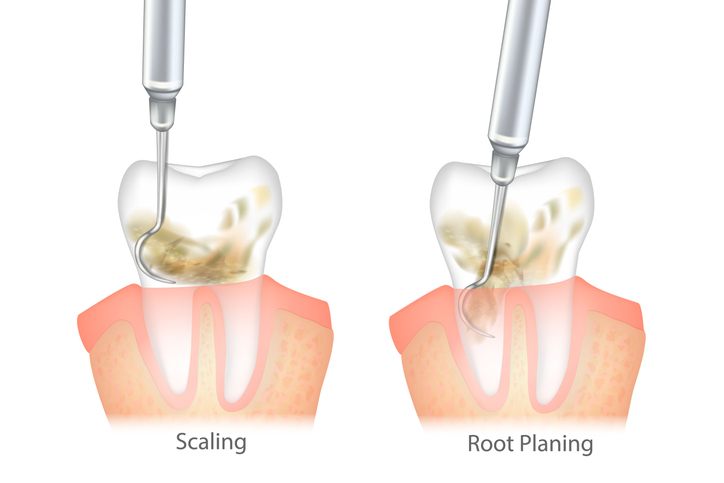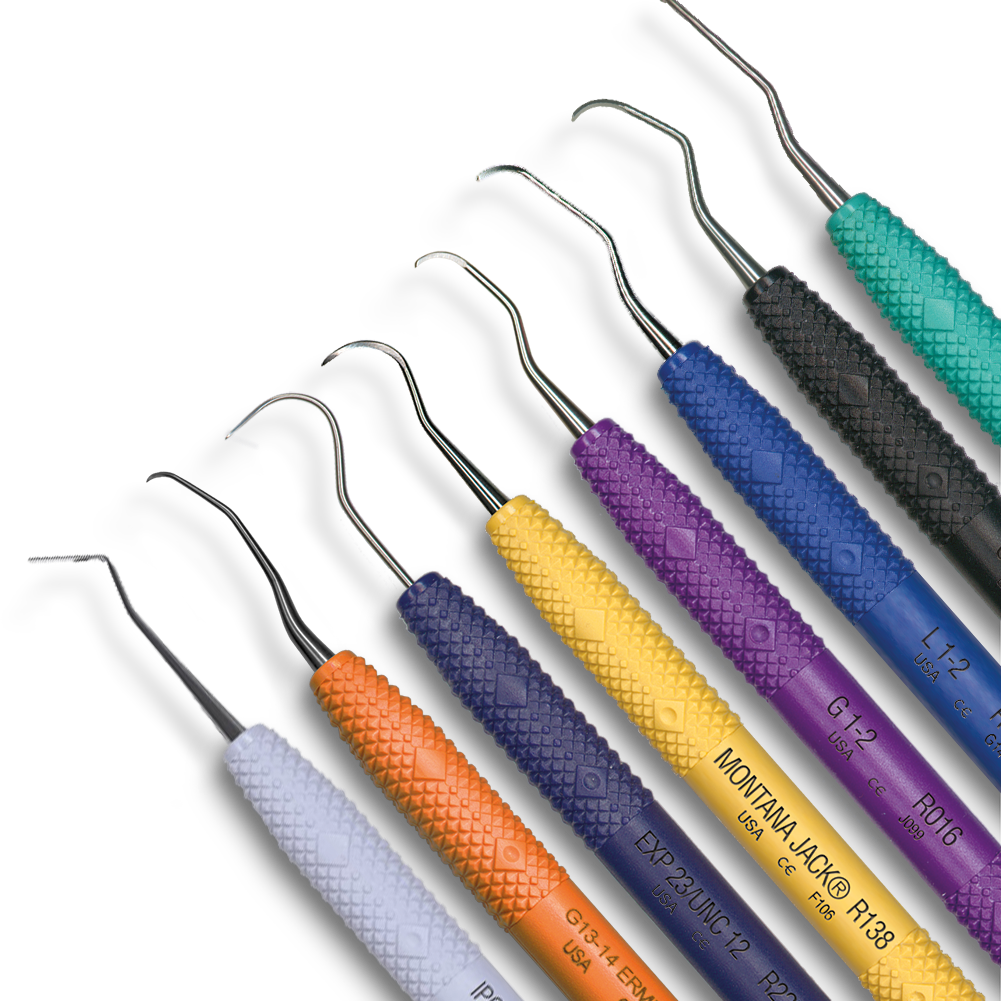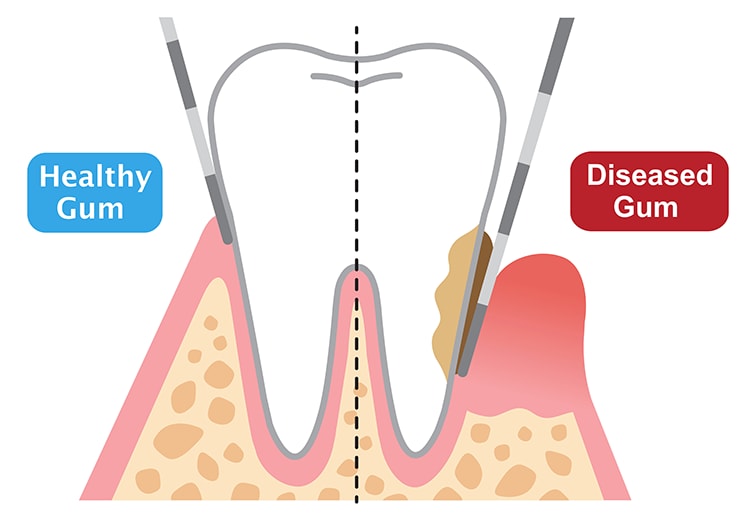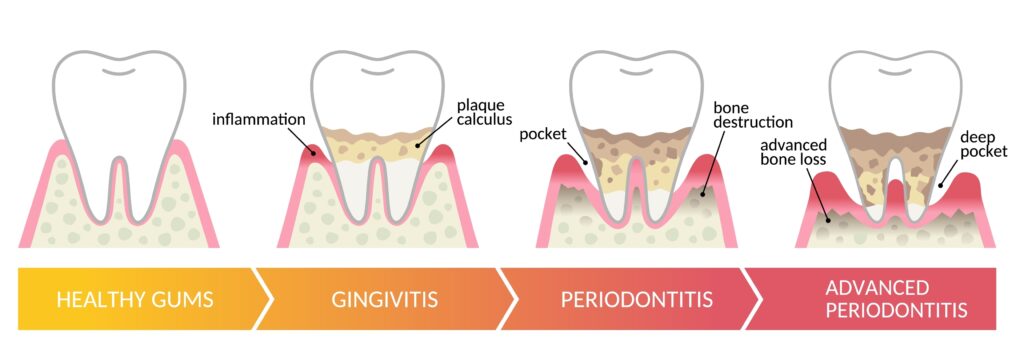What Is Root Planing
Root planing is a crucial dental procedure that helps fight gum disease.
It cleans the roots of your teeth below the gum line, removing harmful buildup and smoothing the surfaces.
Role In Scaling And Root Planing Procedure
Root planing is part of a deep cleaning treatment called scaling and root planing (SRP).
In this process, your dentist first scales your teeth to remove tartar above and below the gum line.
Then, they perform root planing.
Root planing focuses on the roots of your teeth. It removes rough spots and tartar stuck onto the root surface. This smoothing process helps prevent bacteria from sticking to the roots.
The goal is to create a clean, smooth surface for your gums to reattach to your teeth. This can help stop gum disease from getting worse.

Relationship With Deep Cleaning
Root planing is a key part of a deep cleaning.
A deep cleaning goes beyond regular cleanings.
It’s needed when gum disease has caused deep pockets to form between your teeth and gums.
Regular cleanings only remove plaque and tartar above the gum line.
Deep cleanings, including root planing, clean below it.
This thorough cleaning helps fight gum disease more effectively.
Your dentist might recommend a deep cleaning if you have signs of gum disease.
These can include bleeding gums, deep pockets between your teeth and gums, or loose teeth.
Cleaning Root Surfaces
Root planing smooths out tooth roots by removing tartar, bacteria, and damaged parts of the root.
This process has several benefits:
- It helps gum tissue heal and reattach to the teeth
- It reduces inflammation in your gums
- It helps shrink the pockets between your teeth and gums
- It makes it harder for new tartar to form
The smooth surface created by root planing makes it easier for you to keep your teeth clean at home.
This can help prevent worsening of your gum problems.
Common Tools Used
Dentists use special tools for root planing:
- Ultrasonic devices: These use vibrations to break up tartar. They also spray water to wash away debris.
- Hand tools: These include curettes and manual scalers. They help remove smaller deposits and smooth the root surface.
Your dentist will usually use a combination of these tools during your treatment.

Does Root Planing Hurt?
Root planing can cause some discomfort, but your dentist will take steps to keep you comfortable.
They usually use local anesthetic to numb the treatment area before starting.
After the procedure, your gums may feel sore for a few days.
You might also have some sensitivity to hot and cold.
These effects usually go away within a week.
Your dentist may recommend pain relievers such as normal paracetamol to help with any discomfort.
They might also suggest using a soft-bristled toothbrush and avoiding hard foods for a few days after the procedure.
Why Root Planing Is Important For Gum Health
Root planing is crucial for maintaining healthy gums and preventing serious dental issues.
This procedure helps remove harmful bacteria and smooth tooth roots to promote healing and reduce inflammation.
Reducing Gum Inflammation
Root planing plays a key role in reducing gum inflammation.
It removes calculus and plaque that build up below your gum line.
These deposits harbor harmful bacteria that irritate your gums.
By smoothing the root surfaces, root planing makes it harder for bacteria to stick.
This helps your gums reattach to your teeth more easily.
The process can shrink periodontal pockets, which are spaces between your teeth and gums where bacteria thrive.
You may notice less bleeding and swelling in your gums after root planing.
Your gums will likely feel firmer and look pinker, signs of improved health.
Impact Of Untreated Gum Disease
Ignoring gum disease can lead to serious problems.
Without root planing, periodontal disease can worsen, causing:
- Receding gums
- Bone loss in your jaw
- Loose teeth
- Tooth loss

Untreated gum disease allows bacteria to spread deeper into your gum tissue.
This can create larger periodontal pockets and destroy the bone supporting your teeth.
You might experience increased tooth sensitivity and pain when chewing.
Bad breath can become persistent.
In advanced stages, your teeth may shift or fall out.
Connection Between Oral Health And Overall Health
Your oral health is linked to your overall well-being.
Gum disease may increase your risk of:
- Heart disease
- Stroke
- Diabetes complications
- Respiratory infections
The bacteria from infected gums can enter your bloodstream.
This may contribute to inflammation in other parts of your body.
Root planing helps control these bacteria, potentially reducing your risk of related health issues.
By maintaining good oral health, you’re taking an important step in protecting your overall health.
Regular dental check-ups and root planing when needed can help prevent these complications.
Your dentist can spot early signs of gum disease and recommend treatment before it becomes severe.
The Role Of Dental Professionals In Root Planing
Dental professionals play a crucial part in root planing.
Their expertise and specialized tools are essential for effective treatment of gum disease.
Regular dental visits allow for early detection and management of periodontal issues.
Dental Hygienist And Dental Professionals
Dental hygienists and periodontists are key players in root planing procedures.
They have the training and skills to perform this deep cleaning technique.
During your appointment, these professionals will:
- Remove plaque and tartar from below the gumline
- Smooth out rough spots on tooth roots
- Eliminate bacterial toxins
Hygienists often perform the initial scaling and root planing.
For more complex cases, a periodontist may be needed.
These specialists focus on treating gum disease and can handle advanced periodontal issues.
Use Of Dental Probe

Your dental professional will use a dental periodontal probe to assess the health of your gums.
This thin, ruler-like tool measures the depth of gum pockets around your teeth.
Here’s what you can expect:
- The probe is gently inserted between your tooth and gum
- Measurements are taken at multiple points around each tooth
- Deeper pockets indicate more severe gum disease
These measurements help determine if root planing is necessary.
They also guide the dental professional during the procedure, ensuring all affected areas are treated.
Importance Of Regular Dental Check-Ups
Regular dental check-ups are vital for maintaining gum health.
These visits allow your dentist to:
- Detect early signs of gum disease
- Monitor the progression of existing periodontal issues
- Perform professional cleanings to prevent tartar buildup
Aim for dental visits every six months.
If you have a history of gum disease, your dentist may recommend more frequent check-ups.
Early intervention can prevent the need for extensive root planing procedures in the future.
Remember, your role in dental care is just as important.
Brush twice daily, floss regularly, and follow your dentist’s advice between visits.

Post-Root Planing Care: How To Prevent Future Gum Disease
After root planing, you need to take steps to keep your gums healthy.
Good habits at home and regular dental visits are key to avoiding gum problems in the future.
Regular Brushing And Flossing
Brush your teeth twice a day for two minutes each time.
Use a soft-bristled toothbrush and fluoride toothpaste. Be gentle near your gums to avoid irritation.
Floss daily to remove plaque between teeth.
Use a clean section of floss for each tooth to prevent spreading bacteria.
Try an electric toothbrush or water flosser for more thorough cleaning.
These tools can reach spots you might miss with manual brushing and flossing.

Importance Of Regular Dental Cleanings
Professional cleanings every 6 months help prevent gum disease.
Your dentist can remove tartar that builds up despite good home care.
During these visits, your dentist will check for signs of gum problems.
Early detection makes treatment easier and more effective.
Ask your dentist about using an antibacterial mouthwash.
This can help reduce plaque between cleanings.
Avoiding Sticky, Sugary Foods
Cut back on sugary snacks and drinks.
Bacteria feed on sugar and produce acid that harms your teeth and gums.
Avoid sticky foods that cling to teeth.
These are hard to remove and can lead to tooth decay.
Choose tooth-friendly snacks like fruits, vegetables, and cheese.
These foods stimulate saliva flow, which helps clean your mouth.
Drink water throughout the day to rinse away food particles and bacteria.
Following Up On Dental Appointments
Keep all follow-up appointments after your root planing.
Your dentist will check how your gums are healing and if more treatment is needed.
Don’t skip regular check-ups, even if your gums feel fine.
Gum disease can return without symptoms at first.
Tell your dentist about any changes in your mouth, like bleeding gums or tooth sensitivity.
These could be signs of recurring gum problems.
Consider more frequent cleanings if your dentist recommends them.
Some people need extra care to keep their gums healthy.
Preventive Measures For Gum Disease
Good oral hygiene habits and lifestyle choices can help prevent gum disease.
Regular dental check-ups and early intervention are key to maintaining healthy gums and teeth.
Use Of Antimicrobial Mouthwash
Antimicrobial mouthwashes such as chlorhexidine play a crucial role in fighting bacteria that cause gum disease.
Rinse your mouth with the mouthwash for 30 seconds, twice a day.
Make sure to swish it around your entire mouth, including between your teeth.
Don’t eat or drink for at least 30 minutes after using the mouthwash.
This allows the active ingredients to work effectively.
Remember, mouthwash is not a substitute for brushing and flossing.
Use it in addition to these practices for the best results.
Eating Soft Foods
After scaling and root planing, your gums may be sensitive.
Eating soft foods can help prevent irritation and promote healing.
Choose foods that are easy to chew and swallow.
Some good options include:
- Smoothies
- Yogurt
- Mashed potatoes
- Soups
- Scrambled eggs
- Cooked vegetables
Avoid hard, crunchy, or spicy foods that could irritate your gums.
Stay away from very hot or cold foods as well.
Gradually return to your normal diet as your gums heal.
This usually takes a few days to a week.
Avoiding Smoking
Smoking is a major risk factor for gum disease.
It weakens your immune system and makes it harder for your gums to heal.
If you smoke, quitting is one of the best things you can do for your oral health.
Here are some tips to help you quit:
- Set a quit date and stick to it
- Use nicotine replacement therapy
- Seek support from friends, family, or a support group
- Try stress-reduction techniques like exercise or meditation
Even cutting back on smoking can improve your gum health.
Every cigarette you don’t smoke is a step towards healthier gums.
Importance Of Early Treatment
Early treatment of gum disease is crucial for preventing its progression.
Regular dental check-ups can help catch problems early.
Visit your dentist at least twice a year for professional cleanings.
These visits allow your dentist to spot early signs of gum disease.
If you notice any symptoms like red, swollen, or bleeding gums, don’t wait.
Schedule an appointment with your dentist right away.
Early treatment often involves less invasive procedures.
This can save you time, money, and discomfort in the long run.
Remember, gum disease is reversible in its early stages.
Don’t delay seeking treatment if you suspect a problem.
Advanced Treatments For Severe Gum Disease
When regular cleanings aren’t enough, dentists turn to more intensive methods.
These advanced treatments aim to save teeth and restore gum health in cases of severe periodontitis.
Periodontal Surgery
Flap surgery is a common option for advanced gum disease.
Your surgeon will pull back your gums to clean the roots.
They may smooth rough spots or reshape damaged bone.
This helps your gums reattach to healthy bone.
Bone grafting might be needed if periodontitis has destroyed bone.
Your surgeon adds natural or synthetic bone to help regrow lost tissue.
This can save loose teeth from falling out.
Soft tissue grafts can cover exposed roots.
Your surgeon takes tissue from your palate or another source.
They attach it to areas where gums have receded.

Avoiding More Invasive Procedures
Scaling and root planing is a deep cleaning that can prevent the need for surgery.
It removes tartar and smooths root surfaces.
This helps gums reattach to teeth.
Regular check-ups are key.
Your dentist can spot early signs of gum disease.
Quick action can stop it from getting worse.
Good home care is crucial.
Brush twice daily and floss once a day.
Use an antiseptic mouthwash to fight bacteria.
Overview Of Restorative Procedures
If you’ve lost teeth to gum disease, you have options to restore your smile.
Dental implants are a popular choice.
They look and function like natural teeth.
Bridges can fill gaps left by missing teeth.
They attach to nearby healthy teeth for support.
Dentures are removable replacements for missing teeth.
They can be partial or full, depending on your needs.
Periodontal maintenance is ongoing care after treatment.
It includes regular deep cleanings to keep gum disease from returning.
Conclusion
Root planing is a key part of treating gum disease.
This deep cleaning removes tartar and bacteria from below your gum line. It helps your gums reattach to your teeth.
The procedure can stop gum disease from getting worse.
Smooth and clean tooth roots allow your gums to heal properly. This improves your overall oral health.
You may feel some discomfort after the treatment.
But this usually goes away quickly.
Your dentist can give you tips to manage any pain.
Regular dental check-ups are important after root planing.
They help make sure your gums stay healthy. You’ll also need to brush and floss daily at home.
Root planing is often done with scaling.
Together, these treatments are very effective.
They can help you avoid more serious gum problems in the future.
Remember, good oral hygiene is crucial. It helps prevent gum disease from coming back.
Your dentist can show you the best ways to care for your teeth and gums.
Frequently Asked Questions
Root planing is a dental procedure that often raises questions.
Here are some common inquiries about this treatment and its effects on oral health.
What is the difference between root planing and scaling?
Scaling removes plaque and tartar from above and below the gumline.
Root planing smooths the tooth roots to help gums reattach.
Scaling cleans the teeth, while root planing focuses on the roots.
How much does root planing typically cost?
Root planing costs vary by location and dentist.
You can expect to pay between $180 to $300 per quadrant.
Is root planing a necessary procedure?
Root planing is often necessary to treat gum disease.
If you have deep pockets around your teeth or significant gum inflammation, your dentist may recommend this procedure.
What should one expect during recovery from root planing?
After root planing, your gums may be sore for a few days.
You might experience sensitivity to hot and cold.
Avoid hard or sticky foods for a week.
Gentle brushing and rinsing with chlorhexidine mouthwash or warm salt water can help with healing.
Can gums regenerate after undergoing scaling and root planing?
Gums can improve after scaling and root planing.
With proper care, your gums may reattach to your teeth. Full regeneration depends on the severity of your gum disease before treatment.
What are the indications that one might require root planing?
Signs you might need root planing include bleeding gums, receding gums, and persistent bad breath.
If your dentist finds deep pockets when probing your gums, they may suggest this treatment.
If you have experienced any bleeding gums, please contact your dentist as soon as possible for a consultation.
Schedule an appointment with us at 6266 3011 or WhatsApp us at 9636 6118, or check out our services page for more information on scaling and polishing!

